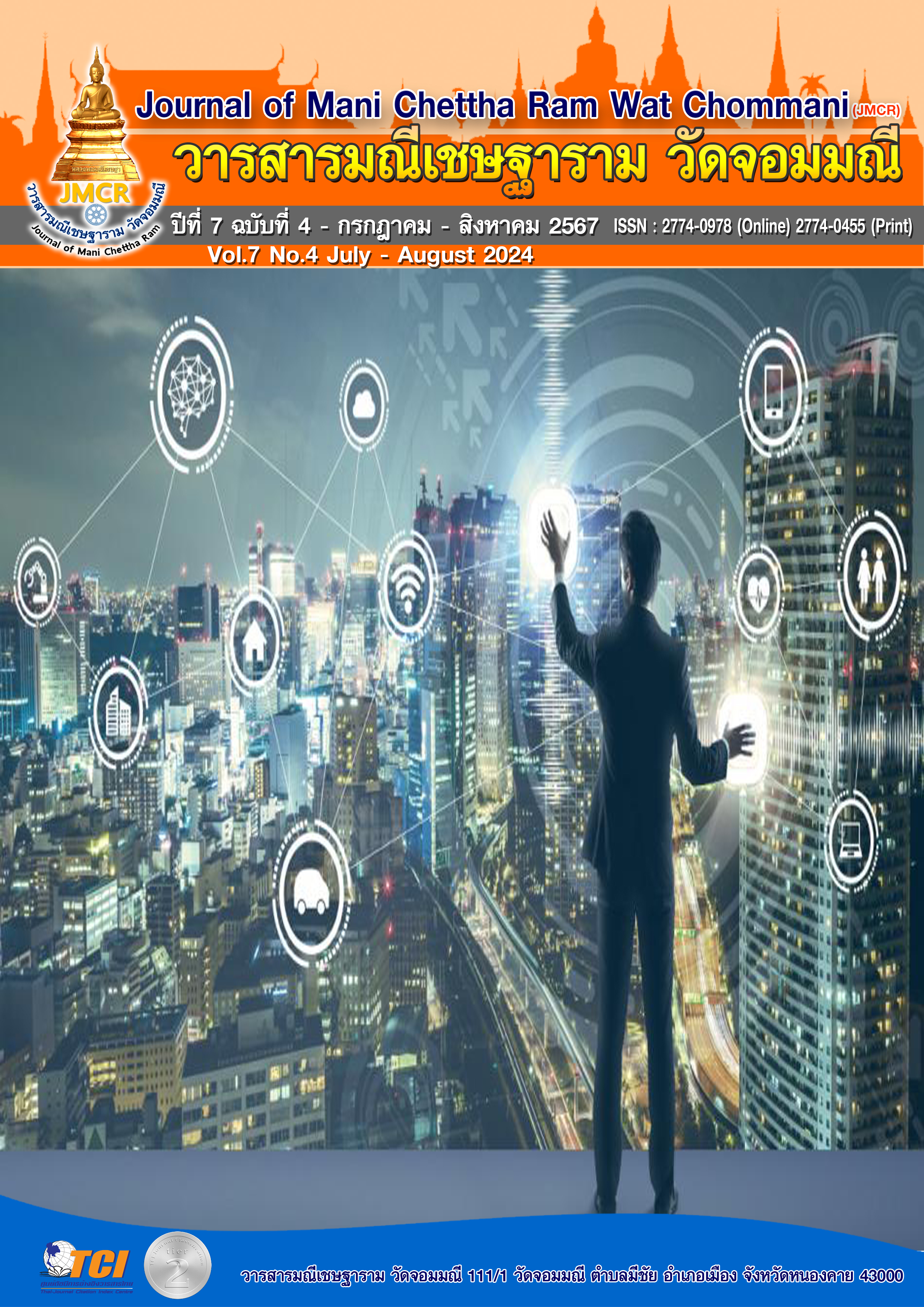พัฒนากระบวนการคิดของครูด้วยการจัดสภาพแวดล้อมการทำงาน
คำสำคัญ:
กระบวนการคิด, ครู, สภาพแวดล้อมการทำงานบทคัดย่อ
ความก้าวหน้าทางเทคโนโลยีและดิจิทัลอย่างรวดเร็วส่งผลกระทบต่อการศึกษาขั้นพื้นฐาน ทำให้รูปแบบการจัดการศึกษามีแนวโน้มเปลี่ยนแปลงไปอย่างสิ้นเชิง สถานศึกษาจำเป็นต้องปรับตัวเป็นองค์กรแห่งการเรียนรู้ พัฒนาหลักสูตรและการสอนที่ทันสมัยเพื่อตอบสนองความต้องการของผู้เรียน การนำเทคโนโลยีมาประยุกต์ใช้ในการเรียนการสอนจะสนับสนุนการเรียนรู้ของผู้เรียน ตามแผนพัฒนาการศึกษาขั้นพื้นฐาน พ.ศ. 2566 – 2570 และยุทธศาสตร์ชาติ 20 ปี ด้านการพัฒนาทักษะสำหรับศตวรรษที่ 21 รวมถึงการเปลี่ยนบทบาทครู การเพิ่มประสิทธิภาพระบบการศึกษา และการพัฒนาระบบการเรียนรู้ตลอดชีวิต สภาพแวดล้อมที่ดีมีผลต่อประสิทธิภาพการทำงานของบุคลากร กระทรวงศึกษาธิการส่งเสริมวิชาชีพครูให้พัฒนาทักษะด้านเทคโนโลยีดิจิทัลเพื่อการเรียนการสอนที่มีประสิทธิภาพ อย่างไรก็ตาม โรงเรียนประถมศึกษาขนาดเล็กยังขาดแคลนงบประมาณและครูที่มีความรู้ด้านเทคโนโลยี ส่งผลให้นักเรียนขาดโอกาสในการเรียนรู้ที่ทันสมัย ซึ่งการปรับปรุงสภาพแวดล้อมการทำงานของครูโดยใช้เทคโนโลยีและการเรียนรู้ที่ทันสมัยสามารถพัฒนาทักษะของนักเรียนและตอบสนองความต้องการของผู้เรียนรายบุคคล การนำเทคโนโลยีและสื่อมาประยุกต์ใช้ช่วยเพิ่มประสิทธิภาพการสอนและผลการเรียนของนักเรียน การสร้างสภาพแวดล้อมที่ดีและเชื่อมโยงกับความสุขของครูเป็นปัจจัยสำคัญที่เพิ่มความมุ่งมั่นและประสิทธิภาพในการทำงาน พื้นที่ทำงานที่เหมาะสมช่วยกระตุ้นความกระตือรือร้นและการพัฒนาตนเอง การใช้เทคโนโลยีทันสมัย เช่น คอมพิวเตอร์ ช่วยเพิ่มประสบการณ์การเรียนรู้ โดยเฉพาะนักเรียนที่มีความแตกต่างทางการเรียน ความสัมพันธ์กับสังคมและองค์กรภายนอกมีความสำคัญในการสนับสนุนและพัฒนาทักษะของครู สภาพแวดล้อมที่ดีช่วยลดความเครียดและส่งผลให้ครูมีสมรรถนะในการสอนและสร้างผลการเรียนที่ดีขึ้น การใช้สื่อและเทคโนโลยีทำให้นักเรียนจดจำและนำไปใช้ในชีวิตประจำวันได้
References
นวพร ชลารักษ์, ภัสราภรณ์ นันตากาศ, รินทร์ลภัส ศิรินพวัฒน์. (2022). การพัฒนารูปแบบการส่งเสริมศักยภาพ ด้านวิชาการและทักษะชีวิตโดยใช้ทักษะกระบวนการคิดของครูและนักเรียนโรงเรียนเครือข่ายการฝึกประสบการณ์วิชาชีพของวิทยาลัยแม่ฮ่องสอน มหาวิทยาลัยราชภัฏเชียงใหม่. รายงานการประชุม Graduate School Conference, 4(1), 1107-1116.
มะยุรีย์ พิทยาเสนีย์ สุภาณี เส็งศรี อรจรีย์ ณ ตะกั่วทุ่ง และธงชัย เส็งศรี. (2565). องค์ประกอบของรูปแบบการเรียนการสอนแบบผสมผสานด้วยกระบวนการคิดเชิงออกแบบร่วมกับการฝึกประสบการณ์วิชาชีพเพื่อส่งเสริมความเป็นนวัตกรของนักศึกษาครู. Journal of Information and Learning, 33(3), 22-33
วีนัส ภักดิ์นรา. (2022). รูปแบบการพัฒนาทักษะกระบวนการคิดขั้นสูงสำหรับนักศึกษาครู. วารสารสันติศึกษาปริทรรศน์ มจร, 10(7), 3050-3067.
Adriana, M., Santoso, D., Hadijaya, Y., & Srinio, F. (2023). Effect of Organizational Climate and Achievement Motivation on Teacher Performance. Nidhomul Haq: Jurnal Manajemen Pendidikan Islam, 8(2), 152-165.
Bayer, D. T. (2021). Effects of Innovative School Leadership Practices With the Goal of Promoting Collective Teacher Efficacy Through Creating a Collaborative Working Environment: A Literature Review.
Danielson, C. (2012). Observing classroom practice. Educational Leadership, 70(3), 32-37.
Darling-Hammond, L., Hyler, M. E., & Gardner, M. (2020). Effective teacher professional development. Palo Alto, CA: Learning Policy Institute.
Filardo, M., Vincent, J. M., & Allen, M. (2019). State of our schools: America’s K-12 facilities. 21st Century School Fund.
Gaille, B. (2018). Advantages and disadvantages of technology in education. Retrieved February.
Guskey, T. R. (2021). Evaluating professional development. Corwin Press.
Hargreaves, A., & O’Connor, M. T. (2018). Collaborative professionalism: When teaching together means learning for all. Corwin Press.
Hattie, J. (2009). The black box of tertiary assessment: An impending revolution. Tertiary assessment & higher education student outcomes: Policy, practice & research, 259, 275.
Jones, W. M., & Dexter, S. (2018). How teachers learn: The roles of formal, informal, and independent learning. Educational Technology Research and Development, 66(4), 901-920.
Koehler, M. J., Greenhalgh, S. P., Rosenberg, J. M., & Keenan, S. L. (2019). What is TPACK? Exploring the concept with teachers. TechTrends, 63(3), 319-329.
Marzano, R. J. (2007). The art and science of teaching: A comprehensive framework for effective instruction. Ascd.
Iis, E. Y., Wahyuddin, W., Thoyib, A., Ilham, R. N., & Sinta, I. (2022). The effect of career development and work environment on employee performance with work motivation as intervening variable at the office of agriculture and livestock in Aceh. International Journal of Economic, Business, Accounting, Agriculture Management and Sharia Administration (IJEBAS), 2(2), 227-236.
Noorhapizah, N., Suriansyah, A., & Abidin, M. (2023). Influence of principal management, work climate on teacher performance through teacher work motivation. International Journal of Curriculum Development, Teaching and Learning Innovation, 1(2), 60-69.
Parinduri, R. Y., Tampubolon, K., & Siregar, B. (2023). The Influence Of Educational Administration On Teacher Performance At Sma Negeri 1 Serbajadi, Serbajadi District, Deli Serdang Regency. International Journal of Educational Review, Law And Social Sciences (IJERLAS), 3(1), 235-248.
Rasonabe, J. (2024). Pedagogical Skills in Relation to Reflective Thinking Process of Teachers. Nexus International Journal of Science and Education, 1(2).
Schneider, M. (2017). Do school facilities affect academic outcomes? National Clearinghouse for Educational Facilities.
Schrum, L., & Levin, B. B. (2020). Leading 21st century schools: Harnessing technology for engagement and achievement. Corwin Press.
Sembiring, E. R. B. (2023). The Influence of Situational Leadership, Work Environment and Innovativeness on Teachers’ Job Satisfaction in Elementary School. International Journal of Social Science and Education Research Studies, 3, 437-450.
Sheninger, E. (2014). Pillars of digital leadership. International Center for Leadership in Education, 1(4), 1-4.
Sutaguna, I. N. T., Yusuf, M., Ardianto, R., & Wartono, P. (2023). The Effect Of ompetence, Work Experience, Work Environment, And Work Discipline On Employee Performance. Asian Journal of Management, Entrepreneurship and Social Science, 3(01), 367-381.
Syamsuddin, A., Juniati, D., & Siswono, T. Y. E. (2020). Understanding the problem solving strategy based on cognitive style as a tool to investigate reflective thinking process of prospective teacher. Universal Journal of Educational Research, 8(6), 2614-2620.
Tampubolon, K., & Sibuea, N. (2023). The Influence Of Supervisory Work Motivation And Competence On The Performance Of School Superintendents In Padangsidimpuan City Education Office. International Journal of Educational Review, Law And Social Sciences (IJERLAS), 3(1), 249-261.
Tannady, H., & Budi, I. S. K. (2023). The Influence of Organization Culture, Work Environment and Leadership On Performance of Fulltime Lecturer (Case Study of Private Higher Education Institution which Supported by Corporate). Journal on Education, 5(4), 13020-13025
Uy, F., Kilag, O. K., Calledo, M. F., Cerna, Y. D., Angtud, N. A., & Villanueva, K. (2024). Quality Performance of Teachers: Work Environment, Work Attitude, and Principal Supervision: Qualitative Investigation. International Multidisciplinary Journal of Research for Innovation, Sustainability, and Excellence (IMJRISE), 1(1), 101-109.
Zamzam, K. F., Sa’dijah, C., & Rahardi, R. (2023). The Creative Thinking Process of Prospective Teachers in Developing Assignments. Journal of Higher Education Theory and Practice, 23(1).


